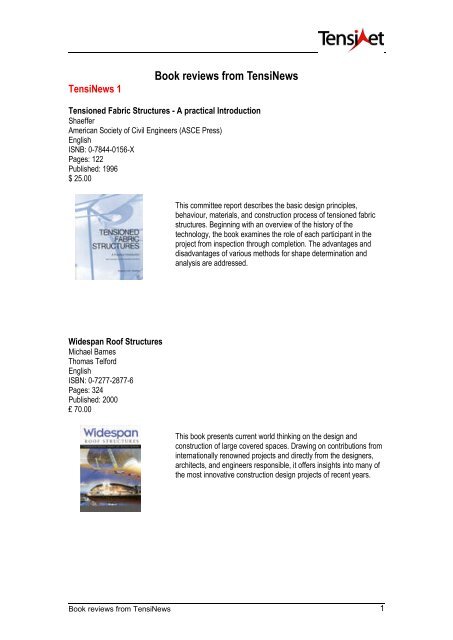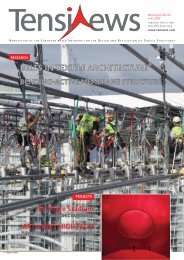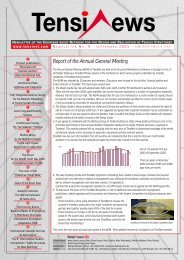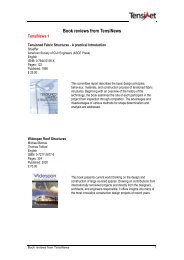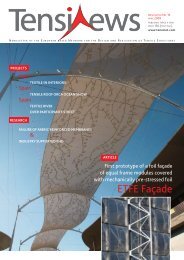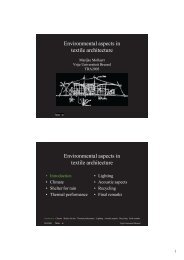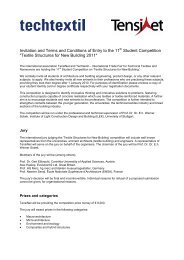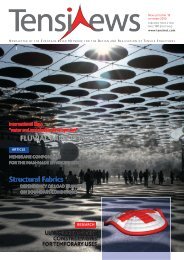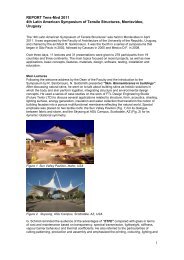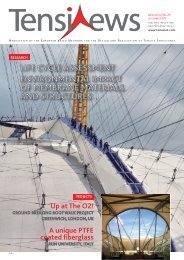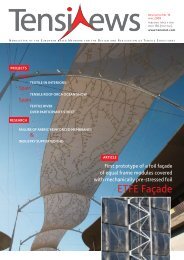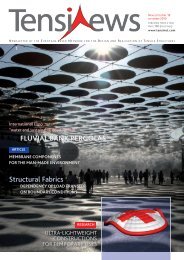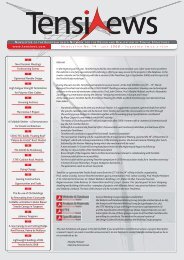Book reviews from TensiNews - TensiNet
Book reviews from TensiNews - TensiNet
Book reviews from TensiNews - TensiNet
You also want an ePaper? Increase the reach of your titles
YUMPU automatically turns print PDFs into web optimized ePapers that Google loves.
<strong>TensiNews</strong> 1<strong>Book</strong> <strong>reviews</strong> <strong>from</strong> <strong>TensiNews</strong>Tensioned Fabric Structures - A practical IntroductionShaefferAmerican Society of Civil Engineers (ASCE Press)EnglishISNB: 0-7844-0156-XPages: 122Published: 1996$ 25.00This committee report describes the basic design principles,behaviour, materials, and construction process of tensioned fabricstructures. Beginning with an overview of the history of thetechnology, the book examines the role of each participant in theproject <strong>from</strong> inspection through completion. The advantages anddisadvantages of various methods for shape determination andanalysis are addressed.Widespan Roof StructuresMichael BarnesThomas TelfordEnglishISBN: 0-7277-2877-6Pages: 324Published: 2000₤ 70.00This book presents current world thinking on the design andconstruction of large covered spaces. Drawing on contributions <strong>from</strong>internationally renowned projects and directly <strong>from</strong> the designers,architects, and engineers responsible, it offers insights into many ofthe most innovative construction design projects of recent years.<strong>Book</strong> <strong>reviews</strong> <strong>from</strong> <strong>TensiNews</strong> 1
<strong>TensiNews</strong> 2Proceedings: The Design of Membrane and Lightweight StructuresMarijke MollaertVUB Brussels, University PressEnglishISBN: 90-5487-321-3Pages: 315Published: 2002€ 65.00 (incl. shipping & VAT)The aim of the symposium 'The Design of Membrane andLightweight Structures', held in Brussels in September 2000, was toincrease interest in and appreciation of membrane and lightweightbuildings. The proceedings illustrate the wide range of applications:the Planet M pavilion (IPL) and the cycle bowl (Foiltec) at EXPO2000, the Millennium Dome (Buro Happold), the Eden project (Mero)and many more.These proceedings can be ordered directly byMarijke.Mollaert@vub.ac.beSoft CanopiesMaritz VandenbergAcademy EditionsEnglishISBN: 185490 440 XPages: 64Published: 1996₤ 16.99Soft Canopies highlights examples of textile canopies <strong>from</strong> therecent work of leading international architects. A variety of buildingsare used to illustrate the current technology being employed in thisfield, including the temporary ticket office for Buckingham palace byMichael Hopkins and Partners, and their earlier Mound Stand atLord's Cricket Ground, London; the extension to the Prophet's HolyMosque in Saudi Arabia by Bodo Rasch and Buro Happold; and theCarlos Moseley Pavilion in New York by FTL Associates sociates and BuroHappold. (80 figures)<strong>Book</strong> <strong>reviews</strong> <strong>from</strong> <strong>TensiNews</strong>2
<strong>TensiNews</strong> 3Information of the Institute for Lightweight Structures (IL)IL 2 Stadt in der Arktis / City in the Arctic Eur 8.-IL 6 Biologie u. Bauen 3 / Biology and Building 3 Eur 10.-IL 14 Anpassungsfähig Bauen / Adaptable Architecture Eur 18.-IL 15 Lufthallenhandbuch / Air Hall Handbook Eur 31.-IL 17 The Work of Frei Otto and his Teams (1955-1976) Eur 6.-IL 18 Seifenblasen / Forming Bubbles Eur 32.-IL 19 Wachsende und sich teilende Pneus / Eur 17.-Growing & Dividing PneusIL 22 Form-Kraft-Masse 2 „Form“ / Form-Force-Mass 2 „Form“ Eur 11.-IL 23 Form-Kraft-Masse 3 „Konstruktion“ / Eur 16.-Form-Force-Mass 3 „ConstructionIL 24 Form-Kraft-Masse 4 „Prinzip Leichtbau“ / Eur 30.-Form-Force-Mass 4 „Lightweight Principle“IL 25 Form-Kraft-Masse 5 “Experimente” / Eur 35.-Form-Force-Mass 5 “Experiments”IL 26 Jugendwettbewerb “Natur und Bauen” / Eur 18.-Youth Competition „Nature & Architecture“IL 28 Diatomeen 1 – Schalen in Natur und Technik / Eur 41.-Diatoms 2 – Shells in Nature and TechnicsIL 31 Bambus – Bauen mit pflanzlichen Stäben / Eur 31.-Bamboo – Building with vegetal rodsIL 33 Radiolaria, Schalen in Natur und Technik II / Eur 37.-Shells in Nature and Technics IIIL 34 Das Modell – The Model – El Modelo Eur 25.-IL 35 Pneu und Knochen / Pneu and Bone Eur 28.-IL 36 Subjektive Standorte – 20 Jahre IL / Eur 14.-Subjective StandpointsIL 39 Ungeplante Siedlungen / Non-Planned Settlements Eur 25.-IL 41 Intelligent Bauen / Building with Intelligence Eur 25.-Examples of IL <strong>Book</strong>sIL 18 Forming BubblesExperiments with liquid films in science,architecture and technics. Minimal ways,minimal surfaces, formfinding models for tents,nets, air halls.IL 35 Pneu and BoneThe structural system pneu in living nature: softpneus, solid pneus, Crustaceans, bones.1988, 400 p., 750 pictures 1995, 262 p., 900 pictures<strong>Book</strong> <strong>reviews</strong> <strong>from</strong> <strong>TensiNews</strong> 3
<strong>TensiNews</strong> 4Art of Engineering / IngenieurskunstWerner BlaserBirkhäuserEnglish / GermanISNB: 3-7643-6001-1Pages: 192Published: 1999Werner Sobek's buildings located in places like Lima, Chicago,Bangkok and Shanghai, show what state-of-the-art engineering iscapable of: structures of fabric, glass, titanium, steel, timbre orconcrete which appear ethereal and virtually devoid of mass, pioneernew methods of building construction and impart astonishingaesthetic qualities to architecture. This book (filled with beautifulphotos and illustrations) introduces the reader to Werner Sobek'swork and professional career while showing the buildings whichresult <strong>from</strong> a close cooperation between architects and engineers.Membrane Designs and Structures in the WorldKazuo IshiiShinkenchiku-shaEnglish / JapaneseISBN: 4-7869-0146-6Pages: 304Published: 1999This book by Kazuo Ishii features 64 built and planned projects <strong>from</strong>around the world. Its more than 300 pages are generously filled withhundreds of colour photos and architectural drawings. The projectsinclude Shanghai Stadium, Osaka Pool, Millennium Dome,Passenger Terminal, Denver International Airport and many others.Several articles are also included as well as a Data List by RoofStructures.<strong>Book</strong> <strong>reviews</strong> <strong>from</strong> <strong>TensiNews</strong> 4
Space Grid StructuresJohn ChiltonArchitectural PressEnglishISBN: 0-7506-3275-5Published: 2000An up-to-date assessment of the use of space grid structures inbuildings by reviewing methods of construction, various systemsavailable and detailed case studies. The technical level is aimed atprofessional and student architects and engineers worldwide andalso serves as a useful constructional manual<strong>Book</strong> <strong>reviews</strong> <strong>from</strong> <strong>TensiNews</strong> 5
<strong>TensiNews</strong> 6The Tensioned Fabric RoofCraig HuntingtonAmerican Society of Civil Engineers (ASCE Press)ISBN: 0-7844-0428-3Pages: 176, soft coverPublished: 2004List $ 89.00International List $ 106.80The Tensioned Fabric Roof describes the state-of-the-art design of fabric tension structures. Thefundamentals of a fabric structure’s design and construction as required by engineers, contractors, andarchitects are presented. The book discusses the unusual character of the fabric structure industry andits implications for how structures are marketed, designed, and constructed. Included are chapters onthe fundamentals of membrane behavior, the possibilities and limitations in roof form, fabric materials,analytical techniques, structural details, fabrication and erection, and non-structural design parametersthat include day lighting, energy use, acoustics, and fire safety. Written by an experienced practitioner offabric structure design, this book methodically addresses all aspects of the design and constructionprocess. Structural engineers will gain an understanding of shaping, analysis, and design of membersand connections; architects will learn the possibilities and limitations in fabric roof form, as well as themeans of achieving successful energy, lighting, acoustical, and fire safety performance; and contractorswill receive invaluable information related to their fabrication and erection.<strong>Book</strong> <strong>reviews</strong> <strong>from</strong> <strong>TensiNews</strong> 7
<strong>TensiNews</strong> 7European Design Guide for Tensile Surface StructuresBrian Forster, Marijke MollaertISBN: 9 789080 868717Pages: 354, soft coverPublished: 2004€ 100.00The European Design Guide for Tensile Surface Structures is aproduct of over three years work by the members of <strong>TensiNet</strong> - AThematic Network for Upgrading the Built Environment in Europethrough Tensile Structures, which was initiated on 1 March 2001.This guide and the other activities of <strong>TensiNet</strong> were funded by theEuropean Commission, under the Competitive and SustainableGrowth (Growth) Programme of Framework Programme 5.The tensile surface structure business has grown considerably in thelast 15 years and is predicted to grow further. Such structures arebecoming bigger and more sophisticated. More clients are interestedin using them but they are still considered to be special – a newtechnology.If tensile surface structures do not figure widely in the designvocabulary of European architects, engineers, urban planners,building owners and national authorities, their application willcontinue to be constrained. Therefore, there is a need for people tobe better informed about the general behaviour and the advantagesand disadvantages of using tensile surface structures in relation tomore conventional buildings. For instance, the internal environmentis seen as a key issue - how do such enclosures behave and to whatfunctions are they suited? There is also the question ofmaintenance. How do these structures differ <strong>from</strong> ‘normal’ buildings?These issues are covered in the design guide.It is a generally held view that Europe needs a code for TensileSurface structures and this design guide is a valuable and necessarystep to a pan-European Normative document. Once an EN isavailable the industry becomes respectable and clients’ confidenceshould increase. In turn, that should lead to more business forconstructors and designers.Nevertheless, this European Design Guide for Tensile SurfaceStructures is not intended to be a European standard. However, as a‘state-of-the-art’ report it is a step in that direction.<strong>Book</strong> <strong>reviews</strong> <strong>from</strong> <strong>TensiNews</strong> 8
<strong>TensiNews</strong> 8Membrane Structures. Innovative Building with Film and FabricKlaus-Michael Koch with Karl J. HabermannPrestelISBN: 3-7913-3049-7Pages: 224Published: 2004$ 136.80This book provides information about numerous innovations in the fieldof materials development, technology and design applicationsincluding the history, materials and use of membrane structures.There are contributions <strong>from</strong> Brian Forster, Knut Göppert, ThomasHerzog, John Pudenz, Bill Taylor, and David Wakefield.<strong>Book</strong> <strong>reviews</strong> <strong>from</strong> <strong>TensiNews</strong>9
<strong>TensiNews</strong> 10ArchitextilesM.G. GarciaWiley-AcademyISBN: 0470026340Pages: 128 (paperback)Published: 2006Architextiles explores the contemporary intersections between architectural and textile design. Focusingon the possibilities for architectural and urban design, this issue examines the most generative set ofconcepts, forms, patterns, materials, processes, technologies, and practices that are driving theproliferation of this multi-disciplinary design hybrid.Architextiles represents a transition stage in spatial design's re-orientation towards a more networked,dynamic, interactive, multi-functional, and communicative state. The paradigms of fashion and textiledesign, with their unique, accelerated aesthetics, and ability to embody a burgeoning, composite, andcomplex range of properties such as lightness, flow, flexibility, surface complexity, and movement, havea natural affinity with architecture's shifts towards a more liquid state. The emergence of Architextiles toarchitectural prominence challenges traditional perceptions and practices of interiors, architectural,urban, landscape, and fashion and textiles. Interweaving new designs and speculative projects on thefuture, Architextiles brings together architects, designers, engineers, technologists, theorists, andmaterial researchers to unravel these new methodologies of fabricating space.Each of the contributors offers a unique insight into the dimensions of Architextiles. This title includes thework of Nigel Coates, Dagmar Richter, Lars Spuybroek, Frederic Migayrou, Peter Testa, DominiquePerrault, Kennedy & Violich, David Wakefield, Bradley Quinn, Robert Kronenburg, Will Alsop, MatildaMcQuaid, Ushida Findlay, Marie O'Mahoney, SHoP, Arup, Tensys, Massimiliano Fuksas, and newprojects and writings <strong>from</strong> young and emerging designers and theorists.<strong>Book</strong> <strong>reviews</strong> <strong>from</strong> <strong>TensiNews</strong> 10
<strong>TensiNews</strong> 12Tensoestructuras: Tensile structures en/in UruguayArq. Roberto SantomauroSpanish / EnglishPages: 128Published: 2008The aim of the book is to give an up to date and generalpresentation on the subject for students, architects, engineers,designers and builders, so that they can get to know the possibilitiesof this constructive technology.It is neither a deep study nor a detailed one in each of the subjectstreated. It is not addressed to those people who have a vastexperience in the subject since it would lead to a more complex workand so it would lose the mentioned target and the global focusintended.The book is conceived to respond to a large number of questionsthat architecture students or colleagues have while designing tensilestructures.There are two parts: one which deals with general basic aspects,and the other which presents a brief description of different projects,in order to make them known and improve the understanding of thesubject.The book is designed in a way to be studied and understoodmethodologically but obviously the real process of designing andbuilding is more dynamic and interactive and requires a process ofsynthesis when making a decision.The book mainly concentrates on membranes applied to architectureas covering or enclosure. Tensile structures can be used for a widerange of architectural programs, with special characteristicsdepending on the system and the material used fulfilling the briefwith its own formal vocabulary.<strong>Book</strong> <strong>reviews</strong> <strong>from</strong> <strong>TensiNews</strong>11
<strong>TensiNews</strong> 13Tension structuresW J LewisThomas TelfordISBN: 0 7277 3236 6Pages: 201, hard coverPublished: 2003£ 30.00The tension structures discussed in this book are predominantlyroofing forms created <strong>from</strong> pre-stressed cable nets, cable trusses,and continuous membranes (fabric structures). A unique feature oftheir design process, which provides a focus for the book, is 'formfinding'- an iterative process of defining the shape of a structureunder tension. The book discusses the role of stable minimalsurfaces (minimum energy forms occurring in natural objects, suchas soap-films) in finding optimal shapes of membrane and cablestructures. The discussion of form-finding is extended to structuralforms the shapes of which are supposedly known, such assuspension bridge cables.The book presents numerical modelling of the structural form andbehaviour of tension structures, but also addresses certainmisconceptions related to their design. It provides unique insightsinto the most commonly used computational methods, emphasisingtheir main strengths and limitations. Mathematical expositions do notgo beyond the level of undergraduate engineering mathematics and,wherever possible, non-mathematical language is used to aidunderstanding of the fundamental concepts. The intention of thebook is to provide a balance between analytical and pictorial aspectsof the subject. Examples presented demonstrate the potential oftension structures as an art form.<strong>Book</strong> <strong>reviews</strong> <strong>from</strong> <strong>TensiNews</strong> 12
Proceedings: Ephemeral Architecture, Time and Textiles<strong>TensiNet</strong> symposium 2007Heidrun Bögner-Balz, Alessandra ZanelliISBN: 9 788870 909326Pages: 419, digitalprintPublished: 2007Full price € 24.00Price <strong>TensiNet</strong> members € 20.00The main theme of the <strong>TensiNet</strong> Symposium 2007 was EphemeralArchitecture and in particular, the relationship between membranearchitecture and the concept of time. Ephemeral Architecturedescribes tensile structures built with lightweight membranes, whichrespond to the principles of firmness, commodity and delight,distancing them <strong>from</strong> the classical interpretation embodied byeverlasting, monumental architecture.The objective of the Symposium is to emphasise how the relationshipbetween membrane architecture and the concept of time isconstantly evolving, giving new life to all ephemeral architecturalexpressions.Ephemeral Textile Architecture not only responds to the needs ofcontemporary society for flexible and lightweight building, but is alsothe result of an ecological design strategy, where temporaryconstructions can be disassembled after use, leaving futuregenerations free to decide how to use those spaces again.<strong>Book</strong> <strong>reviews</strong> <strong>from</strong> <strong>TensiNews</strong> 13
<strong>TensiNews</strong> 15International Journal of Space Structures (IJSS)Special edition - Tensioned membrane constructionProfessor R. MotroPublished quarterlyISBN: 0266-3511The aim of the journal is to provide an international forum for theinterchange of information on all aspects of analysis, design andconstruction of space structures.The scope of the journal encompasses structures such as single-,double- and multi-layer grids, barrel vaults, domes, towers, foldedplates, radar dishes, tensegrity structures, stressed skin assemblies,foldable structures, pneumatic systems and cable arrangements. Nolimitation on the type of material is imposed and the scope includesstructures constructed in steel, aluminium, timber, concrete, plastics,paperboard and fabric.The journal aims at striking a balance between theory and practiceand creating a platform for exchange of information betweenstructural engineers, architects, civil engineering contractors, systemmanufacturers and research workers in academic and non-academicestablishments.The journal includes regular <strong>reviews</strong> of technical publications, booksand trade literature. Also included is information on recently builtimportant space structures, recently held conferences andforthcoming events of interest.The Journal also publishes Special editions. One of the forthcomingSpecial editions will be “Tensioned membrane construction”.Papers in this Special Edition were selected <strong>from</strong> over 40 presentedat the <strong>TensiNet</strong> Association Symposium “Ephemeral Architecture:Time and Textiles” held at the Politecnico di Milano, in 16-18 April2007. They cover a wide range of topics, <strong>from</strong> Campioli,Mangiarotti and Zanelli’s historical review of textile architecture inthe Italian context, and Hennicke’s inspirational account ofrelationships between lightweight and natural structures and tensilearchitecture, to the more mathematically analytical approach inGosling and Bridgens’ presentation of a new concept for materialstesting of architectural fabrics and Wagner’s paper describing simpleanalytical design/checking tools for single/double-curved membranesand inflated cushions. To complement these, Adriaenssensexamines the feasibility of spliced-spine stressed medium-spanmembranes and, as a practical case study, Stimpfle describes theredesign and installation of the Velodrome roof in Abuja, Nigeria.For more info see http://www.multi-science.co.uk/space.htm<strong>Book</strong> <strong>reviews</strong> <strong>from</strong> <strong>TensiNews</strong> 14
Tensoestructuras/Tensile structures, desde/<strong>from</strong>: UruguayArq. Roberto SantomauroArq. Eduardo Folle ChavannesSpanish/EnglishGrafic design and Digital imaging: Rodolfo Fuentes BaezPrefaces: Nicholas Goldsmith, FAIA, New York, USA; Juan Monjo Carrió, Madrid, SPAIN and BruceWright, USA.Pages: 128, full colourPublished: 2008The aim of the book is to give an up to date and general presentationon the subject for students, architects, engineers, designers andbuilders, so that they can get to know the possibilities of thisconstructive technology. It is neither a deep study nor a detailed onein each of the subjects treated. It is not addressed to those peoplewho have a vast experience in the subject since it would lead to amore complex work and so it would lose the mentioned target andthe global focus intended. The book is conceived to respond to alarge number of questions that architecture students or colleagueshave while designing tensile structures. There are two parts: onewhich deals with general basic aspects, and the other which presentsa brief description of different projects, in order to make them knownand improve the understanding of the subject. The book is designedin a way to be studied and understood methodologically butobviously the real process of designing and building is more dynamicand interactive and requires a process of synthesis when making adecision. The book mainly concentrates on membranes applied toarchitecture as covering or enclosure. Tensile structures can be usedfor a wide range of architectural programs, with specialcharacteristics depending on the system and the material usedfulfilling the brief with its own formal vocabulary.Internet sale www.sobresaliente.com<strong>Book</strong> <strong>reviews</strong> <strong>from</strong> <strong>TensiNews</strong> 15
<strong>TensiNews</strong> 16New Tent ArchitecturePhilip DrewThames & Hudson LtdEnglishISBN-10: 0500342431ISBN-13: 9780500342435Pages: 208 pages (hardcover)Published: 2008Interest in tensile structures is fast growing thanks to ecologicalconcerns and the new possibilities offered by cutting-edge materialsand technologies.Tents have been prized for centuries for their lightness, mobility,small footprint and structural elegance. New tents offer innovativeand significant solutions to age-old problems. With the demand onarchitects to touch the earth lightly, together with a cross-disciplinaryinterest in technotextiles, membrane structures are assuming newprominence and pleasing forms.This wide-ranging international survey looks at the excitingpossibilities of contemporary tensile building and the most interestingmembrane structures created in recent years.Includes:• Architectural and cultural history of the tent• Thirty recent projects grouped by theme, such as atrium covers andfabric walls, ring roofs and convertibles, small peaks, large waves• Accessible text descriptions, photographs and line drawings.Internet sale: www.thameshudson.co.uk<strong>Book</strong> <strong>reviews</strong> <strong>from</strong> <strong>TensiNews</strong> 16
ETFETechnology and DesignAnnette LeCuyerBirkhauserEnglishISBN: 978-3-7643-8563-7Pages: 160 pages (hardcover)Published: 2008ETFE foil has recently become an important material for the claddingof technologically sophisticated and innovative buildings. Thismaterial is very thin and lightweight and, when used in air-filledcushion assemblies, has enormous strength and a range of adaptiveenvironmental attributes. ETFE cushion enclosures became widelyknown primarily through Grimshaw Architects’ Eden Project andHerzog & de Meuron’s Allianz Arena, and they are being used on thespectacular swimming stadium for the 2008 Olympic Games inBeijing, the largest ETFE building envelope in the world so far.This book is conceived as an in-depth introduction to thecharacteristics of ETFE and its applications in construction. Projectexamples explore in detail the specific characteristics of ETFEbuilding skins in the areas of structural behavior, light transmission,insulation, acoustics, fire engineering and environmentalmodification.Internet sale: www.springer.com/birkhauser<strong>Book</strong> <strong>reviews</strong> <strong>from</strong> <strong>TensiNews</strong> 17
Kengo KumaBreathing ArchitectureThe teahouse of the Museum of Applied Arts FrankfurtVolker Fischer, Ulrich SchneiderBirkhauser BostonEnglish, GermanISBN: 978-3-7643-8787-7Pages: 131 pages (soft cover)Published: 2008Kengo Kuma's Teahouse is a masterly reinterpretation of a classicalJapanese building type. Delivered in August 2007 for the Park of theFrankfurt Museum of Applied Arts (a Richard Meier Building), Kuma'sinnovative structure in flexible, semi-transparent, 'breathing' Tenara-Membrane - inflated by means of a pneumatic system to a blossomlike form - houses in the interior the classical elements for Japanesetea ceremony. Integrated LED technology allows the use of theteahouse at night; the interior can be heated by way of themembrane.The monograph, including an original text by Kuma himself, gives anin-depth documentation of this lyrical temporary structure – anoutstanding example of ephemeral architecture, combining poetryand technology - with many unpublished sketches, technical plansand with splendid colour photographs.Internet sale: www.birkhauser.com<strong>Book</strong> <strong>reviews</strong> <strong>from</strong> <strong>TensiNews</strong> 18
<strong>TensiNews</strong> 17Fabric ArchitectureCreative Resources for Shade, Signage and ShelterSamuel J. ArmijosW. W. Norton & Co.EnglishISBN-10: 0393732363ISBN-13: 978-0393732368Pages: 304 pages (hardcover), 476 colour photographsPublished: 1 edition (16 Nov 2008)Fabric Architecture is a resource catalogue devoted to celebratingmembrane structures. With over 300 examples of awnings, tents,umbrellas, and tensioned membrane structures <strong>from</strong> around theworld, it is the reference book for ideas and inspiration.As an added feature, there are six fabric samples included in thebook: PTFE <strong>from</strong> Saint Gobain, Coated PVC and PVC mesh <strong>from</strong>Ferrari, HDPE <strong>from</strong> Multiknit, Silicone coated fiberglass <strong>from</strong> Atexand Gore’s Tenara.The book can be used as a reference guide, course book, a sellingtool or as a gift for your employees, clients, family and friends.Internet sale: www.wwnorton.com<strong>Book</strong> <strong>reviews</strong> <strong>from</strong> <strong>TensiNews</strong> 19
Philippe Samyn ConstructionsArchitect and EngineerPierre Puttemans and Pierre SpehlFonds mercatorEnglish, French, DutchISBN: 978 90 6153 840 0 (English edition)ISBN: 978 90 6153 843 1 (Dutch edition)ISBN: 978 90 6153 841 7 (French edition)Pages: 480 pages (hardcover with jacket)Published: December 2008The book presents a vast panorama of the prolific and imaginativework of Philippe Samyn and Partners, placing it in context among thearchitectural movements of the last forty years. Their greatachievement is the balance they have struck between architectureand engineering in a remarkable synthesis of spatial and structuralconcepts and the physical laws of construction. In the history ofcontemporary architecture, this position relates to that of rareinnovators like Victor Horta, Frank Lloyd Wright, Auguste Perret orJean Prouvé. It also links to the premises of the Modern Movementconcerning the necessity of symbiosis between form, function andtechnique. Notable in this respect has been their continuous researchinto sustainable development with a strong emphasis on integrationinto the urban or rural environment. Though sometimes spectacular,their work never indulges in gratuitous exhibitionism, courting fashionand notoriety. Rather it cultivates its own sense of harmony throughthe correctness of its proportions and the logic of its design.Internet sale: www.fondsmercator.be<strong>Book</strong> <strong>reviews</strong> <strong>from</strong> <strong>TensiNews</strong> 20
<strong>TensiNews</strong> 18Spanish edition European Design Guide for Tensile Surface StructuresArquitectura TextilGuía Europea de Diseño de las Estructuras Superficiales TensadasBrian Forster, Marijke MollaertEditorial Munilla-LeriaSpanishTranslation: Carmen O. MenéndezCoordination Spanish edition: Juan Monjo CarrióISBN: 978-84-89150-82-9Pages: 326 pages( soft cover)Published: 2009In 2004 TENSINET (initially the European Network of TensileStructures, later re-named the Tensinet Association) completed aproject in which its members had engaged for over two years: theformulation of the first design guide for this type of structures,published that same year. The guide immediately became aninternational reference for the design and engineering of tensionedmembrane structures, particularly any involving woven fabric. Itcontains a full description of the options available in this type ofstructures, as well as the aspects relevant to both architecturaldesign and structural and service engineering. It is, in short, acomplete guide for designers involved in this type of construction.Shortly after the international association was founded, theestablishment of regional chapters was seen to be a desirablecorollary. That idea materialized with the creation of the IberianSection (Tensinet Ibérica), which groups the Tensinet membersheadquartered in Spain or Portugal, and possibly in the future, inLatin America.The Iberian Section was instituted at a meeting of its members heldat Guimarães, Portugal, in October 2006.One of the Section’s first tasks was to translate the Tensinet designguide, both as an aid for its present and future members and as acontribution to the construction industry’s expertise. The aim was tofurnish more complete information on tensioned membranetechnology and tensile architecture in general, making such formallyand operationally attractive solutions more readily accessible todesigners. The contributions of many Tensinet Ibérica members wereinstrumental to its publication.<strong>Book</strong> <strong>reviews</strong> <strong>from</strong> <strong>TensiNews</strong> 21


